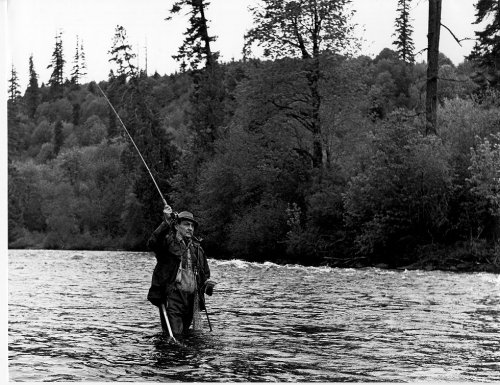Read these examples of positive behaviour which supports conservation, and negative
behaviour which hurts conservation. After reading each example, jot down notes about the
positive or negative example in your own words. Use a chart like this:
| Examples |
Negative Examples |
| |
|
| |
|
| |
|
| |
|
Photo © Mary
Randlett
 |
Positive Example: Roderick Haig-Brown sets his
own limits when fishing by never taking fish that are smaller than ten inches long.
Positive Example: Fish and wildlife governments
set limits which safely reflect the availability of salmon.
Negative Example: "I knew a man who used to kill
every year over a thousand trout in two months' fishing on a big lake; later in the year he used to
kill around three hundred salmon, sometimes in catches of thirty or forty in a single day. He
always fished from a boat, always with fly, usually with two rods. And he liked to kill fish. I
think he was nuts; he thought I was nuts. If the point of going fishing is to catch and kill fish,
undoubtedly he was right. If the point of going fishing is to have a good time with a minimum of
destruction, maybe I have a point." (Valerie Haig-Brown, To Know a River p. 359).
Positive Example: "Quality fishing...implies
preservation, so far as possible, of natural conditions in the waters, their surroundings and the
fish themselves." (Valerie Haig-Brown, To
Know a River p. 352).
Negative Example: "Ill-considered logging practices
have also done much damage: an absurd little logging splash dam at the outlet of Adams Lake
totally wiped out the important sockeye run to the upper Adams River and this particular genetic
stock has not yet been sufficiently replaced." (Roderick Haig-Brown, "The Fraser Watershed and The Moran Proposal" p.3).
Positive Example: "Elkhorn, when a government
was damming its river, had to fight and fight hard to save the salmon run...Runs of game and
commercial fish can be destroyed by poorly planned dams; but sound planning can always find
some way to compensate and may even save the whole resource," (Roderick
Haig-Brown, Measure of the Year p.
216-217).
Negative Example: "After pollution, unneeded and
ill-planned dams and diversions are the greatest destroyers" of fisheries of all kinds, (Valerie Haig-Brown, "Some Approaches to
Conservation" p. 175-176)
Positive Example: "Such modern management
methods as flow control, temperature control, gravel improvement, bank protection, can be
highly constructive." (Valerie Haig-Brown, "Some Approaches to Conservation" p. 177)



